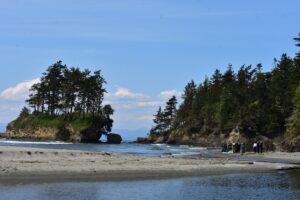
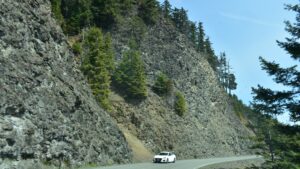 Eocene Bedrock Geology of the Northern Olympic Peninsula: Arrival of the Siletzia Oceanic Terrane, Washington
Eocene Bedrock Geology of the Northern Olympic Peninsula: Arrival of the Siletzia Oceanic Terrane, Washington
WHEN: July 25-26, 2025 (Friday and Saturday)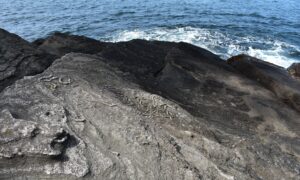
Quimper Geological Society (QGS) had an exciting two-day field trip on Friday, July 25, and Saturday, July 26, 2025, to the North Olympic Peninsula, led by led by Professor Erin Donaghy (University of Nevada, Las Vegas, sedimentologist and field geologist) with Carol Serdar Tepper (retired geologist, Washington Department of Ecology) and Jeff Tepper (Professor emeritus, University of Puget Sound) as co-leaders.
We looked at rocks related to docking of the Siletzia oceanic terrane, including volcanic and sedimentary units that formed while Siletzia was still offshore as well as, stratigraphic sequences that record both the pre-docking (Crescent and Aldwell Formations) and post-docking (Lyre, Hoko, and Makah Formations) history. At each stop we examined the rocks and discuss the field and lab techniques that were used to infer their paleo-environments and tectonic implications. The trip included some strenuous hiking/walking and several hours of driving each day, in places on paved but winding roads.
Logistical details for the trip are as follows: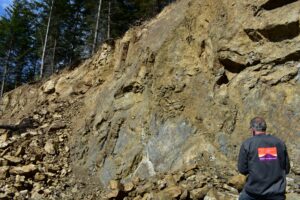
- The trip will begin both days at the Olympic National Park Visitor Center in Port Angeles, Washington, and will return there at the end of day one. More specifics will be provided once registration is finalized. Both days (Friday and Saturday) will begin at 8:30 AM (please DO NOT be late), end times may vary.
- The group will be limited to 20 QGS members. (There will be additional geologists along to assist.) Spaces filled on a first-come, first reserved basis.
- Participants should make their own arrangements for lodging in or near Port Angeles on Friday night (depending on your starting point on Friday (Day 1), you may also want to book both Thursday and Friday nights). Hotel availability can be tight during the summer, so booking early is recommended.
- Participants should be in good physical health and comfortable walking several miles each day with some hikes being at ~6000 feet elevation.
- Due to limited parking at some stops, carpooling is a must. We will coordinate this in advance as part of the registration process. Please offer your host driver money for gas and National Park fee (if applicable). If you are unable to carpool, please do not apply for registration.
- Summer road construction along Highway 101 will increase your travel time, sometimes unexpectedly. Plan ahead.
- The cost of the trip is $90, which includes box lunches both days and copy of the field guide.
TO BECOME REGISTERED: 1. Print the registration form; 2. Print all information completely; 3. Write a check (sorry, we are a small group) to: JEFFERSON LAND TRUST; 4. Send registration form and check to the P.O. Box on the form.
About the leaders
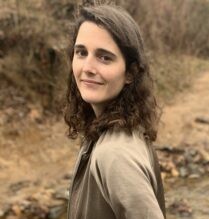 Erin Donaghy, geology professor at the University of Nevada, Las Vegas is a sedimentologist who studies the evolution of sedimentary basins that form along active convergent margins. Her field work focuses on the west coast of North America, in particular the exotic terranes in western Alaska and the north Olympic Peninsula, Washington.
Erin Donaghy, geology professor at the University of Nevada, Las Vegas is a sedimentologist who studies the evolution of sedimentary basins that form along active convergent margins. Her field work focuses on the west coast of North America, in particular the exotic terranes in western Alaska and the north Olympic Peninsula, Washington.

Carol Serdar Tepper, a licensed geologist, has spent her entire life on the Puget Sound playing with rocks. She began her career as a science teacher. She subsequently worked for Washington State mapping landslides and regulating surface mining, timber harvest impacts, and water-quality compliance. She is currently the leader and advisor for the Quimper Geologic Society.
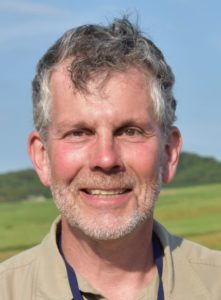 Jeff Tepper, Professor emeritus at the University of Puget Sound, taught courses in mineralogy, petrology, and geochemistry before retiring in 2021. His research focuses on the magmatic and tectonic history of the Pacific Northwest and on environmental chemistry of water and sediment of local lakes.
Jeff Tepper, Professor emeritus at the University of Puget Sound, taught courses in mineralogy, petrology, and geochemistry before retiring in 2021. His research focuses on the magmatic and tectonic history of the Pacific Northwest and on environmental chemistry of water and sediment of local lakes.



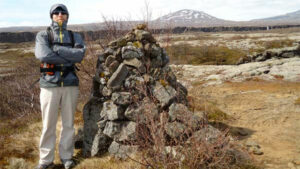


 Eocene Bedrock Geology of the Northern Olympic Peninsula: Arrival of the Siletzia Oceanic Terrane, Washington
Eocene Bedrock Geology of the Northern Olympic Peninsula: Arrival of the Siletzia Oceanic Terrane, Washington

 Erin Donaghy, geology professor at the University of Nevada, Las Vegas is a sedimentologist who studies the evolution of sedimentary basins that form along active convergent margins. Her field work focuses on the west coast of North America, in particular the exotic terranes in western Alaska and the north Olympic Peninsula, Washington.
Erin Donaghy, geology professor at the University of Nevada, Las Vegas is a sedimentologist who studies the evolution of sedimentary basins that form along active convergent margins. Her field work focuses on the west coast of North America, in particular the exotic terranes in western Alaska and the north Olympic Peninsula, Washington.
 Jeff Tepper, Professor emeritus at the University of Puget Sound, taught courses in mineralogy, petrology, and geochemistry before retiring in 2021. His research focuses on the magmatic and tectonic history of the Pacific Northwest and on environmental chemistry of water and sediment of local lakes.
Jeff Tepper, Professor emeritus at the University of Puget Sound, taught courses in mineralogy, petrology, and geochemistry before retiring in 2021. His research focuses on the magmatic and tectonic history of the Pacific Northwest and on environmental chemistry of water and sediment of local lakes.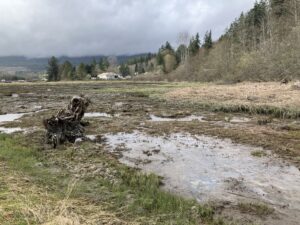
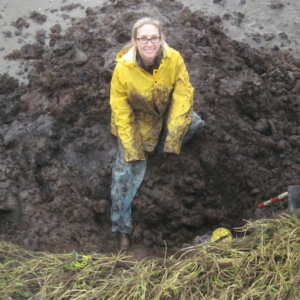 Dr. Carrie Garrison-Laney is a Coastal Hazards Specialist at Washington Sea Grant and a liaison to the NOAA Center for Tsunami Research. A focus of Carrie’s research has been the age and distribution of paleo-tsunami deposits with lessons learned from historical events. She earned her PhD from the University of Washington.
Dr. Carrie Garrison-Laney is a Coastal Hazards Specialist at Washington Sea Grant and a liaison to the NOAA Center for Tsunami Research. A focus of Carrie’s research has been the age and distribution of paleo-tsunami deposits with lessons learned from historical events. She earned her PhD from the University of Washington.